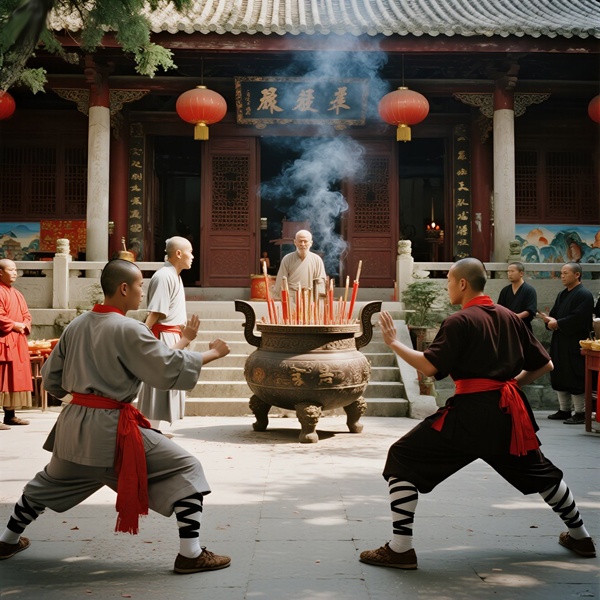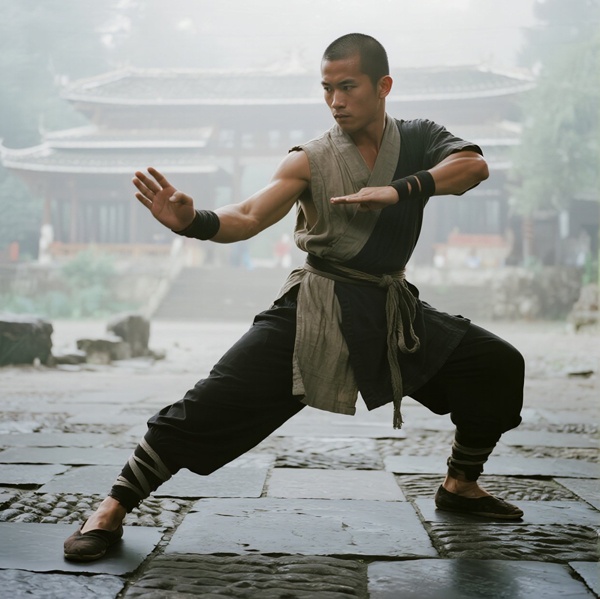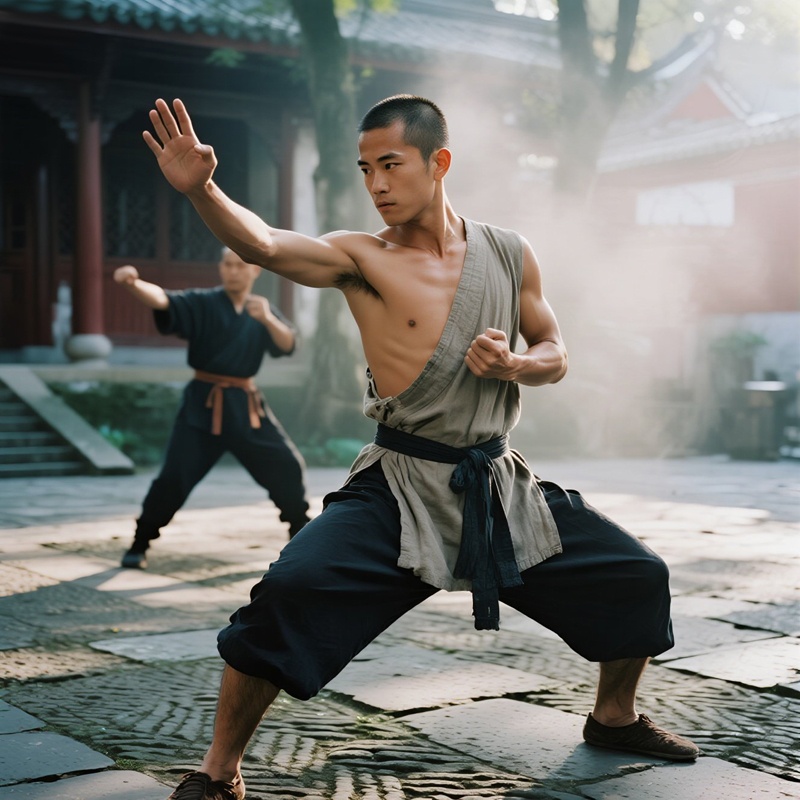The Five Great Fists: Exploring the Core of Guangdong's Southern Chinese Martial Arts (Nanquan)
Introduction:Guangdong Province is the vibrant heartland of Southern Chinese Martial Arts (Nanquan) , a distinct branch of Kung Fu known for its powerful stances, intricate hand techniques, and dynamic close-range combat. At the foundation of this rich tradition lies the legendary "Five Great Fists" (五大名拳 - Wǔ Dà Míng Quán) – Hung Kuen (洪拳) , Lau Kuen (刘拳) , Choy Kuen (蔡拳) , Li Kuen (李拳) , and Mok Kuen (莫拳) . These styles form the bedrock of Guangdong Nanquan and embody the region's martial heritage, deeply intertwined with history and legend.

The Pillars of Guangdong Nanquan: The Five Great Fists
Hung Kuen (洪拳 - Hong Quan / Hung Gar):
Origins: Perhaps the most renowned, Hung Kuen traces its legendary roots to the Southern Shaolin Temple . Folklore credits its creation to Hung Hei-Gun (洪熙官) , a Fujian tea merchant, who passed it to the Five Ancestors of the Hung Mun (洪门) .
History in Guangdong: Flourishing after its transmission to Guangdong, it became the largest and most influential Southern style.
Lineage & Masters: Boasting a prestigious lineage, famous exponents include Hung Man-Tin (洪文定), Luk Ah-Choy (陆亚彩), Tit Kiu Sam (铁桥三), Lam Fuk-Sing (林福成), the iconic Wong Fei-Hung (黄飞鸿) , and his disciple Lam Sai-Wing (林世荣).
Hung Kuen, Hung Gar, Hong Quan, Southern Shaolin, Hung Mun, Wong Fei-Hung, Guangdong Kung Fu, Southern Fist foundation.
Lau Kuen (刘拳 - Liu Quan):
Origins: The origins of Lau Kuen are attributed to various figures – either Lau Sam-Ngaan (刘三眼) , Lau Saang (刘生) of the "Lower Four Prefectures" (下四府), or Lau Ching-Saan (刘青山) .
Regional Focus: Primarily practiced and preserved within the Leizhou Peninsula (雷州半岛) region of Guangdong.
Lau Kuen, Liu Quan, Leizhou Peninsula martial arts, traditional Southern Kung Fu.
Choy Kuen (蔡拳 - Cai Quan):
Origins: Choy Kuen is said to have been founded by Southern Shaolin monks , specifically Choy Bak-Daat (蔡伯达) and Choy Gau-Yi (蔡九仪) .
Spread in Guangdong: This style found its stronghold in areas like Zhongshan (中山) within Guangdong.
Choy Kuen, Cai Quan, Southern Shaolin Kung Fu, Zhongshan martial arts, traditional Nanquan.
Li Kuen (李拳 - Li Quan):
Origins: Legends offer two main narratives: creation by Southern Shaolin monk Li Sik-Hoi (李色开) , later taught by Guangdong's Li Yau-Saan (李友山) of Xinhui; or direct founding by Li Ying-Fai (李应辉) of Huizhou.
Popularity: Li Kuen became widely practiced across diverse locations like Zhongshan, Heyuan (河源), Gaozhou (高州), Longchuan (龙川), and Guangzhou (广州).
Li Kuen, Li Quan, Guangdong martial arts styles, Southern Fist styles, Xinhui Kung Fu.
Mok Kuen (莫拳 - Mo Quan):
Origins: Like others, its creation is linked to the Southern Shaolin, either attributed to the famous Abbot Jee-Sin (至善禅师) or to Mok Daat-Si (莫达士) , who passed it to Mok Ching-Giu (莫清骄) .
Region: This style predominantly circulated within the Pearl River Delta (珠江三角洲) region, including major centers like Guangzhou and Foshan.
Mok Kuen, Mo Quan, Pearl River Delta Kung Fu, Jee Sin, Southern Shaolin styles.

Shared Heritage & Significance:Crucially, most of the Five Great Fists share a common legendary origin: transmission from the Fujian Southern Shaolin Temple (福建南少林) . Furthermore, their history is deeply, and often secretly, intertwined with the Hung Mun (洪门) Tiandihui (天地会) society, a significant anti-Qing dynasty fraternal organization. This connection highlights that these styles were not merely martial arts systems; they were integral parts of active historical "Jianghu" (江湖 - martial underworld) factions in Southern China.
Beyond the Five: The Rich Tapestry of Guangdong Nanquan
While the Five Great Fists form the core, Guangdong Southern Kung Fu is incredibly diverse. Numerous other influential styles developed or took root in the region:
Choy Lee Fut (蔡李佛拳): Founded by Chan Heung (陈享) of Xinhui. He synthesized the essence of Choy Kuen (from monk Choy Fook - 蔡福 ), Li Kuen (from Li Yau-Saan ), and Fut Gar Kuen (佛家拳) (from Chan Yuen-Woo - 陈远护 ), creating one of the most widespread and popular Southern styles globally. (Keyword: Choy Lee Fut, Chan Heung, Xinhui Kung Fu)
Fu Hok Seung Ying Kuen (虎鹤双形拳 - Tiger Crane Double Form Fist): Created by Lam Sai-Wing (林世荣) , Wong Fei-Hung's disciple. It masterfully combines Hung Kuen (洪拳) techniques and power ("Hung Head") with the fluid structure and footwork of Fut Gar Kuen (佛家拳) ("Buddha Tail"), earning the nickname "Hung Tao Fut Mei" (洪头佛尾) . (Keyword: Tiger Crane Double Form, Lam Sai-Wing, Wong Fei-Hung lineage)
Wing Chun (咏春拳): Gaining immense global fame, legends attribute its creation to Yim Wing-Chun (严咏春/嚴三娘) , or link its arrival in Guangzhou (specifically the Temple of Filial Piety - 光孝寺 ) to Abbot Jee-Sin (至善禅师) . It flourished significantly in Foshan. (Keyword: Wing Chun, Yim Wing Chun, Foshan Kung Fu, Jee Sin)
Other Notable Styles: The landscape includes Hap Gar Kuen (侠拳) (brought from Emei by "Big Knight" Lee Wu-Jee - 李胡子 ), Bak Mei Kuen (白眉拳) (from Emei's Bak Mei - 白眉道人 ), Fut Gar Kuen (佛家拳) (originating from Buddhist temples), alongside Lin Bou Kuen (练步拳) , Lin Sau Kuen (练手拳) , Diu Ga Kuen (刁家教) , Ngok Ga Kuen (岳家教) , Chu Ga Kuen (朱家教) , Kwanlun Kuen (昆仑拳) , Lam Ga Kuen / Nam Ji Kuen (南枝拳) , and Yu Ga Kuen (儒拳) . (Keywords: Southern Chinese martial arts, Hap Gar, Bak Mei, Fut Gar, diverse Kung Fu styles)
Conclusion:The Five Great Fists (Hung, Lau, Choy, Li, Mok) are more than just martial arts; they are the living history and cultural pillars of Guangdong Southern Fist (Nanquan) . Emerging from the legendary Southern Shaolin and intertwined with the Hung Mun Tiandihui , their legacy is enriched by countless other styles like Choy Lee Fut , Tiger Crane , and Wing Chun . Together, they represent a profound and dynamic system of traditional Chinese Kung Fu , captivating practitioners and enthusiasts worldwide with their power, history, and technical depth. Exploring these styles offers a journey into the heart of Southern China's martial soul.




